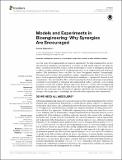Models and Experiments in Bioengineering: Why Synergies Are Encouraged
Author(s)
Malandrino, Andrea
DownloadMalandrino-2016-Models and Experiments.pdf (103.8Kb)
PUBLISHER_CC
Publisher with Creative Commons License
Creative Commons Attribution
Terms of use
Metadata
Show full item recordAbstract
Does the future of bioengineering lie in models or experiments? The long-standing debate on how and how much experimental and theoretical research in our field should cooperate can shape the future. This debate means often a choice, early in the bioengineer’s career. A bioengineer may prefer to address scientific questions based on experimental tests, or on computational and theoretical analyses. This fundamental choice can drive the future bioengineer’s mindset. Unsurprisingly, laboratories and researchers often assemble in separate, competitive teams. Indeed, the way bioengineers tackle a question is shaped by the characteristic techniques – experimental, theoretical, and computational – they are trained for. Here, without neglecting the obvious advantages of specializing exclusively in experimental, or theoretical and computational studies, I advocate a way of doing synergistic research that combine different approaches. Moreover, I believe that bioengineering desperately needs synergy and cooperation to pave the way for significant discoveries. We need efforts to train a new generation of biomedical engineers: individuals who take advantage of these synergies, who design projects accordingly, and who make these approaches work cooperatively.
Date issued
2016-01Department
Massachusetts Institute of Technology. Department of Mechanical EngineeringJournal
Frontiers in Bioengineering and Biotechnology
Publisher
Frontiers Research Foundation
Citation
Malandrino, Andrea. “Models and Experiments in Bioengineering: Why Synergies Are Encouraged.” Frontiers in Bioengineering and Biotechnology 3 (January 11, 2016).
Version: Final published version
ISSN
2296-4185